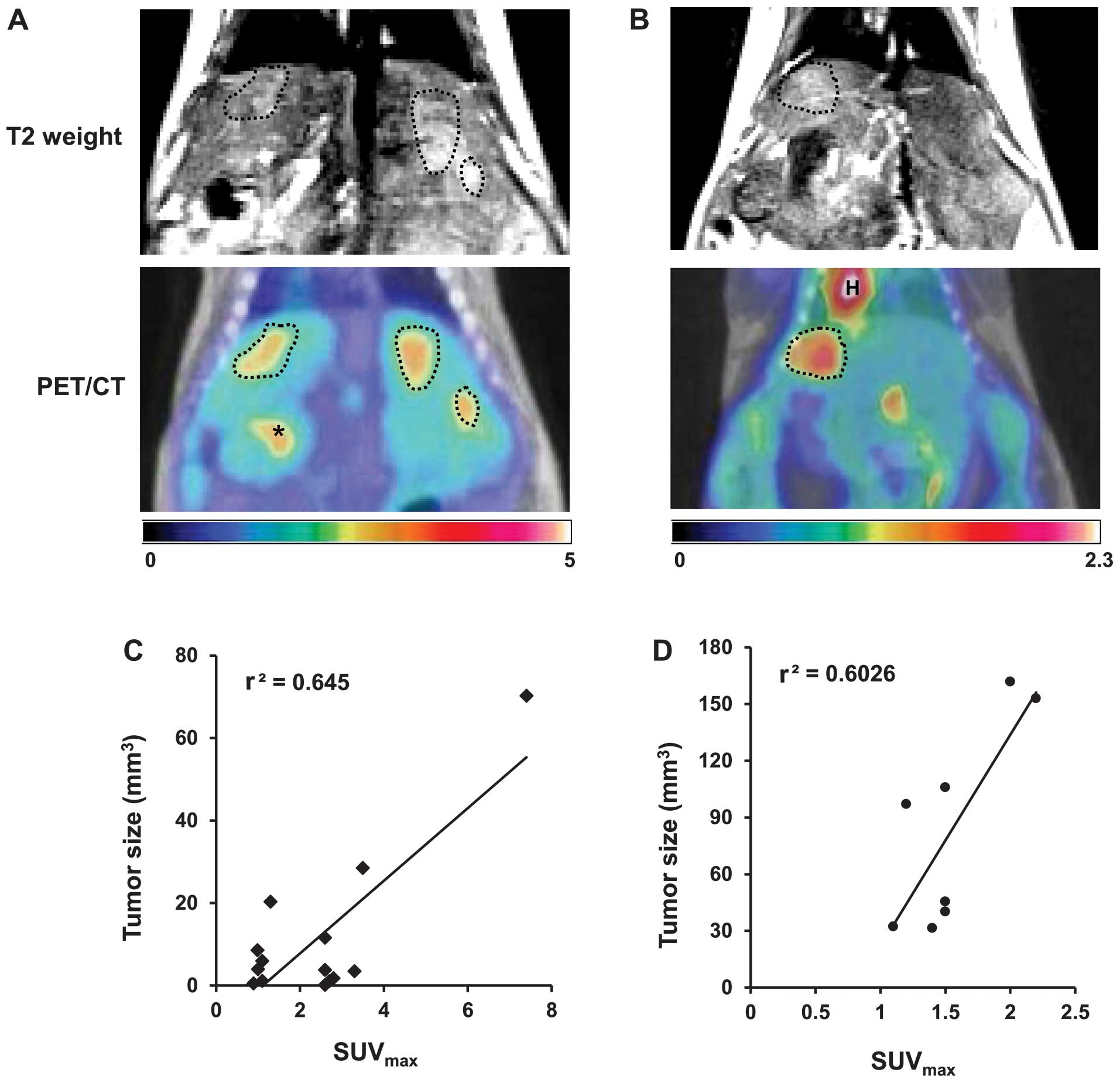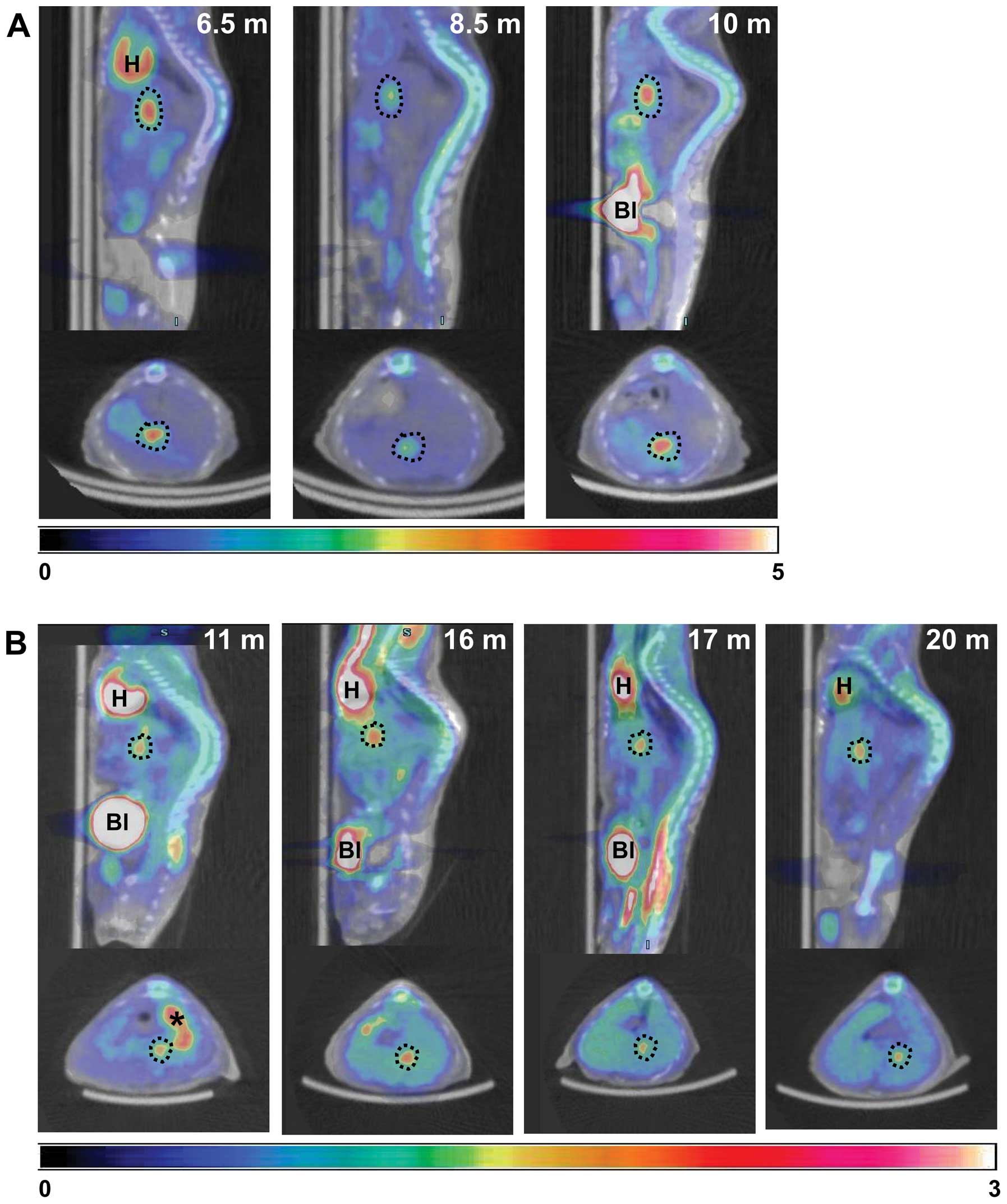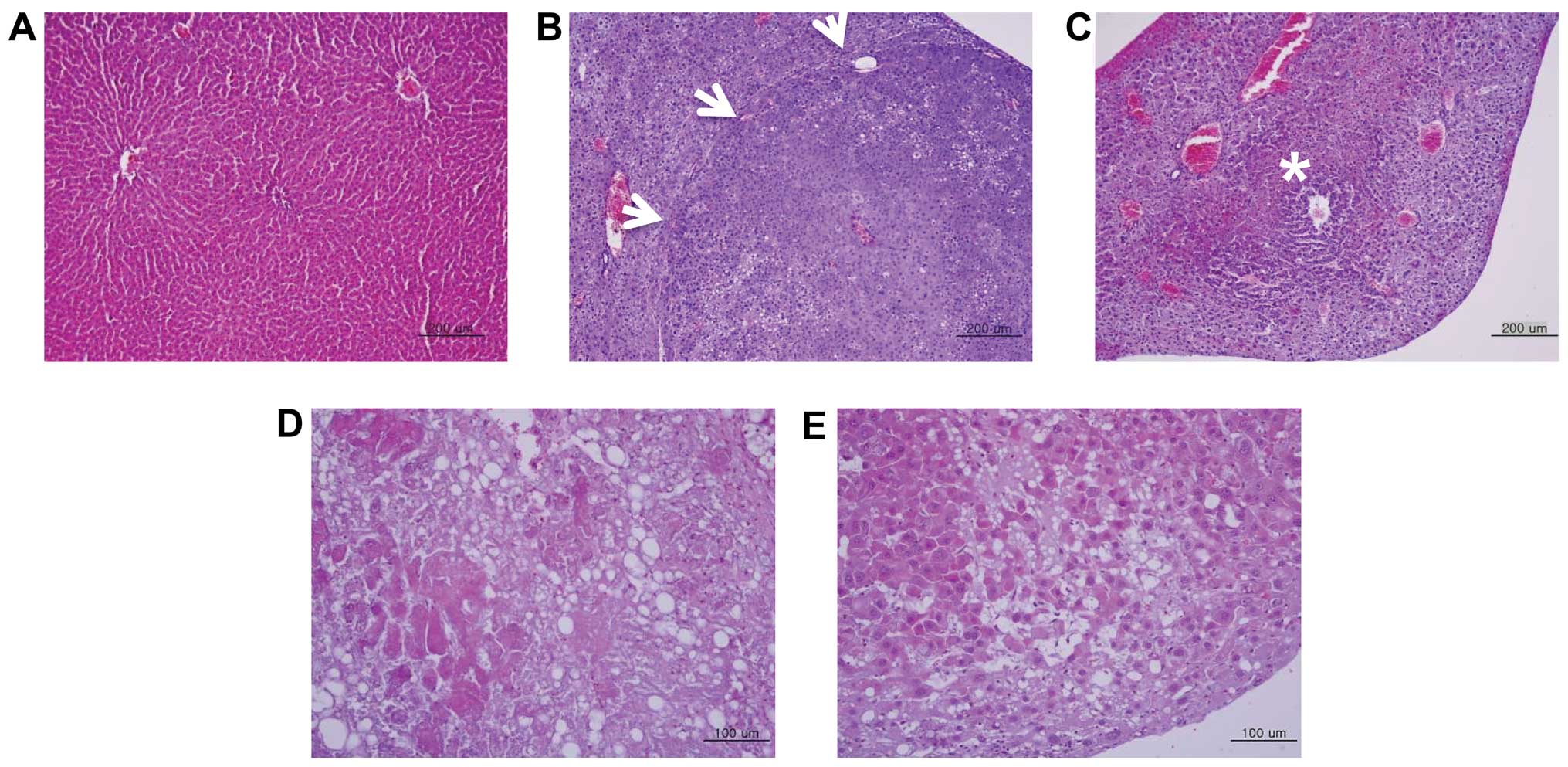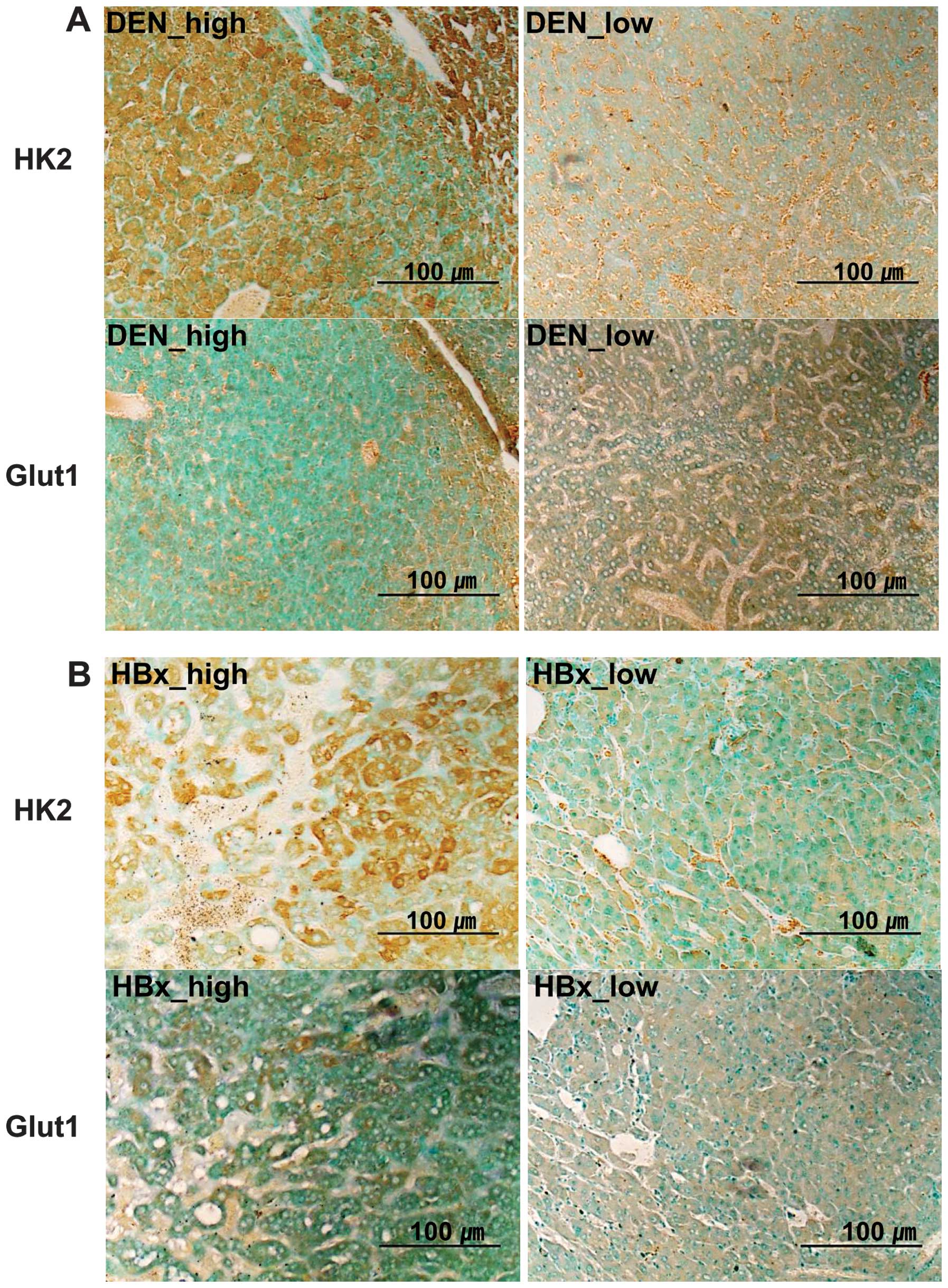|
1
|
Weissleder R: Scaling down imaging:
Molecular mapping of cancer in mice. Nat Rev Cancer. 2:11–18. 2002.
View Article : Google Scholar : PubMed/NCBI
|
|
2
|
Kang JH and Chung JK: Molecular-genetic
imaging based on reporter gene expression. J Nucl Med. 49:164–179.
2008. View Article : Google Scholar
|
|
3
|
Kelloff GJ, Hoffman JM, Johnson B, et al:
Progress and promise of FDG-PET imaging for cancer patient
management and oncolytic drug development. Clin Cancer Res.
11:2785–2808. 2005. View Article : Google Scholar : PubMed/NCBI
|
|
4
|
Warburg O: On the origin of cancer cells.
Science. 123:309–314. 1956. View Article : Google Scholar : PubMed/NCBI
|
|
5
|
Southworth R, Parry CR, Parkes HG, Medina
RA and Garlick PB: Tissue-specific differences in 2-f
luoro-2-deoxyglucose metabolism beyond FDG-6-P: a 19F NMR
spectroscopy study in the rat. NMR Biomed. 16:494–502. 2003.
View Article : Google Scholar : PubMed/NCBI
|
|
6
|
Okazumi S, Isono K, Enomoto K, et al:
Evaluation of liver tumours using fluorine-18-fluorodeoxyglucose
PET: characterization of tumor and assessment of effect of
treatment. J Nucl Med. 33:333–339. 1992.PubMed/NCBI
|
|
7
|
Khandani AH and Wahl RL: Applications of
PET in liver imaging. Radiol Clin North Am. 43:849–860. 2005.
View Article : Google Scholar : PubMed/NCBI
|
|
8
|
Trojan J, Schroeder O, Raedle J, et al:
Fluorine-18 FDG positron emission tomography for imaging of
hepatocellular carcinoma. Am J Gastroenterol. 94:3314–3319. 1999.
View Article : Google Scholar : PubMed/NCBI
|
|
9
|
Delbeke D, Martin WH, Sandler MP, Chapman
WC, Wright JK Jr and Pinson CW: Evaluation of benign vs malignant
hepatic lesions with positron emission tomography. Arch Surg.
133:510–515. 1998. View Article : Google Scholar : PubMed/NCBI
|
|
10
|
Khan MA, Combs CS, Brunt EM, et al:
Positron emission tomography scanning in the evaluation of
hepatocellular carcinoma. J Hepatol. 32:792–797. 2000. View Article : Google Scholar : PubMed/NCBI
|
|
11
|
Kudo M: Diagnostic imaging of
hepatocellular carcinoma: Recent Progress. Oncology. 81:73–85.
2011. View Article : Google Scholar
|
|
12
|
Paradis V: Histopathology of
hepatocellular carcinoma. Recent Results. Cancer Res. 190:21–32.
2013.
|
|
13
|
Kelland LR: Of mice and men: values and
liabilities of the athymic nude mouse model in anticancer drug
development. Eur J Cancer. 40:827–836. 2004. View Article : Google Scholar : PubMed/NCBI
|
|
14
|
Frese KK and Tuveson DA: Maximizing mouse
cancer models. Nat Rev Cancer. 7:645–658. 2007. View Article : Google Scholar : PubMed/NCBI
|
|
15
|
Thorgeirsson SS and Santoni-Rugiu E:
Transgenic mouse models in carcinogenesis: interaction of c-myc
with transforming growth factor alpha and hepatocyte growth factor
in hepatocarcinogenesis. Br J Clin Pharmacol. 42:43–52. 1996.
View Article : Google Scholar : PubMed/NCBI
|
|
16
|
Harada N, Oshima H, Katoh M, Tamai Y,
Oshima M and Taketo MM: Hepatocarcinogenesis in mice with
beta-catenin and Ha-Ras gene mutations. Cancer Res. 64:48–54. 2004.
View Article : Google Scholar : PubMed/NCBI
|
|
17
|
Yu DY, Moon HB, Son JK, et al: Incidence
of hepatocellular carcinoma in transgenic mice expressing the
hepatitis B virus X-protein. J Hepatol. 31:123–132. 1999.
View Article : Google Scholar : PubMed/NCBI
|
|
18
|
Zheng Y, Chen WL, Louie SG, Yen TS and Ou
JH: Hepatitis B virus promotes hepatocarcinogenesis in transgenic
mice. Hepatology. 45:16–21. 2007. View Article : Google Scholar
|
|
19
|
Finnberg N, Stenius U and Högberg J:
Heterozygous p53-deficient (+/−) mice develop fewer p53-negative
preneoplastic focal liver lesions in response to treatment with
diethylnitrosamine than do wild-type (+ / +) mice. Cancer Lett.
207:149–155. 2004. View Article : Google Scholar : PubMed/NCBI
|
|
20
|
McGlynn KA, Hunter K, LeVoyer T, et al:
Susceptibility to aflatoxin B-1-related primary hepatocellular
carcinoma in mice and humans. Cancer Res. 63:4594–4601.
2003.PubMed/NCBI
|
|
21
|
Salguero Palacios R, Roderfeld M, Hemmann
S, et al: Activation of hepatic stellate cells is associated with
cytokine expression in thioacetamide-induced hepatic fibrosis in
mice. Lab Invest. 88:1192–1203. 2008. View Article : Google Scholar : PubMed/NCBI
|
|
22
|
Weisburger EK: Carcinogenicity studies on
halogenated hydrocarbons. Environ Health Perspect. 21:7–16. 1977.
View Article : Google Scholar : PubMed/NCBI
|
|
23
|
Teoh NC, Dan YY, Swisshelm K, et al:
Defective DNA strand break repair causes chromosomal instability
and accelerates liver carcinogenesis in mice. Hepatology.
47:2078–2088. 2008. View Article : Google Scholar : PubMed/NCBI
|
|
24
|
Qi Y, Chen X, Chan CY, et al:
Two-dimensional differential gel electrophoresis/analysis of
diethylnitrosamine induced rat hepatocellular carcinoma. Int J
Cancer. 122:2682–2688. 2008. View Article : Google Scholar : PubMed/NCBI
|
|
25
|
Rao KV and Vesselinovitch SD: Age- and
sex-associated diethylnitrosamine dealkylation activity of the
mouse liver and hepatocarcinogenesis. Cancer Res. 33:1625–1627.
1973.PubMed/NCBI
|
|
26
|
Naugler WE, Sakurai T, Kim S, et al:
Gender disparity in liver cancer due to sex differences in
myd88-dependent IL-6 production. Science. 317:121–124. 2007.
View Article : Google Scholar : PubMed/NCBI
|
|
27
|
Sell S: Mouse models to study the
interaction of risk factors for human liver cancer. Cancer Res.
63:7553–7562. 2003.PubMed/NCBI
|
|
28
|
Schmid A, Rignall B, Pichler BJ and
Schwarz M: Quantitative analysis of the growth kinetics of
chemically induced mouse liver tumors by magnetic resonance
imaging. Toxicol Sci. 126:52–59. 2012. View Article : Google Scholar : PubMed/NCBI
|
|
29
|
Hueper K, Elalfy M, Laenger F, et al:
PET/CT imaging of c-myc transgenic mice identifies the genotoxic
n-nitroso-diethylamine as carcinogen in a short-term cancer
bioassay. PLoS One. 7:e304322012. View Article : Google Scholar : PubMed/NCBI
|
|
30
|
Heijink DM, Kleibeuker JH, Nagengast WB,
et al: Total abdominal 18F-FDG uptake reflects
intestinal adenoma burden in Apc mutant mice. J Nucl Med.
52:431–436. 2011. View Article : Google Scholar : PubMed/NCBI
|
|
31
|
Lee JS, Chu IS, Mikaelyan A, et al:
Application of comparative functional genomics to identify best-fit
mouse models to study human cancer. Nat Genet. 36:1306–1311. 2004.
View Article : Google Scholar : PubMed/NCBI
|
|
32
|
Binato M, Kruel Schmidt M, Silveira
Volkweis B, et al: Mouse model of diethylnitrosamine-induced
gastric cancer. J Surg Res. 148:152–157. 2008. View Article : Google Scholar : PubMed/NCBI
|
|
33
|
Gray R, Peto R, Brantom P and Grasso P:
Chronic nitrosamine ingestion in 1040 rodents: the effect of the
choice of nitrosamine, the species studied and the age of starting
exposure. Cancer Res. 51:6470–6491. 1991.PubMed/NCBI
|
|
34
|
Lu X, Guo H, Molter J, et al:
Alpha-fetoprotein-thymidine kinase-luciferase knock-in mice: a
novel model for dual modality longitudinal imaging of tumorigenesis
in liver. J Hepatol. 55:96–102. 2011. View Article : Google Scholar : PubMed/NCBI
|
|
35
|
Park JH, Kim KI, Lee YJ, et al:
Non-invasive monitoring of hepatocellular carcinoma in transgenic
mouse with bioluminescent imaging. Cancer Lett. 310:53–60.
2011.PubMed/NCBI
|
|
36
|
Kim KI, Park JH, Lee YJ, et al: In vivo
bioluminescent imaging of α-fetoprotein-producing hepatocellular
carcinoma in the diethylnitrosamine-treated mouse using recombinant
adenoviral vector. J Gene Med. 14:513–520. 2012. View Article : Google Scholar : PubMed/NCBI
|
|
37
|
Koike K: Hepatitis B virus X gene is
implicated in liver carcinogenesis. Cancer Lett. 286:60–68. 2009.
View Article : Google Scholar : PubMed/NCBI
|
|
38
|
Madden CR, Finegold MJ and Slagle BL:
Hepatitis B virus X protein acts as a tumor promoter in development
of diethyl-nitrosamine-induced preneoplastic lesions. J Virol.
75:3851–3858. 2001. View Article : Google Scholar : PubMed/NCBI
|
|
39
|
Freimuth J, Gassler N, Moro N, et al:
Application of magnetic resonance imaging in transgenic and
chemical mouse models of hepatocellular carcinoma. Mol Cancer.
9:942010. View Article : Google Scholar : PubMed/NCBI
|
|
40
|
Lee JD, Yang WI, Park YN, et al: Different
glucose uptake and glycolytic mechanisms between hepatocellular
carcinoma and intrahepatic mass-forming cholangiocarcinoma with
increased (18)F-FDG uptake. J Nucl Med. 46:1753–1759.
2005.PubMed/NCBI
|


















